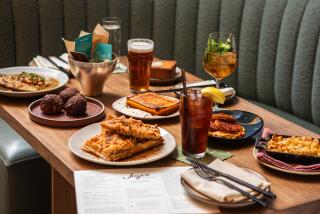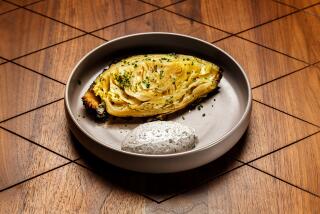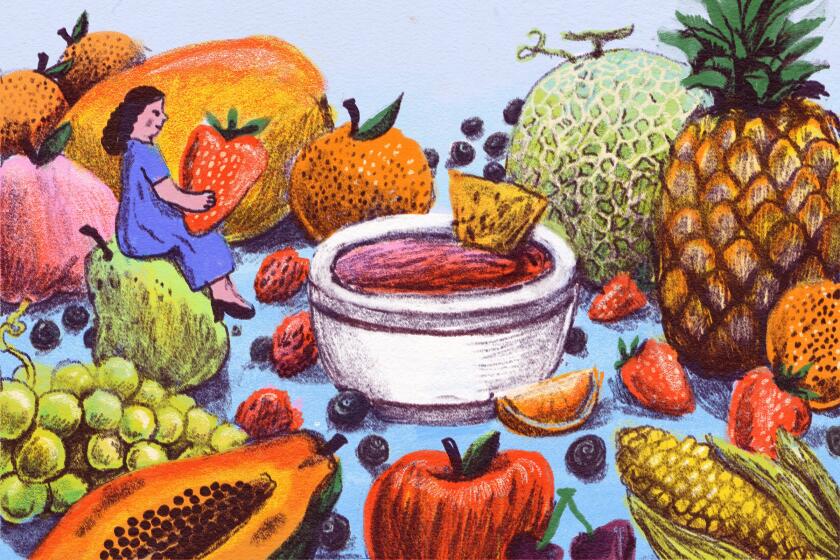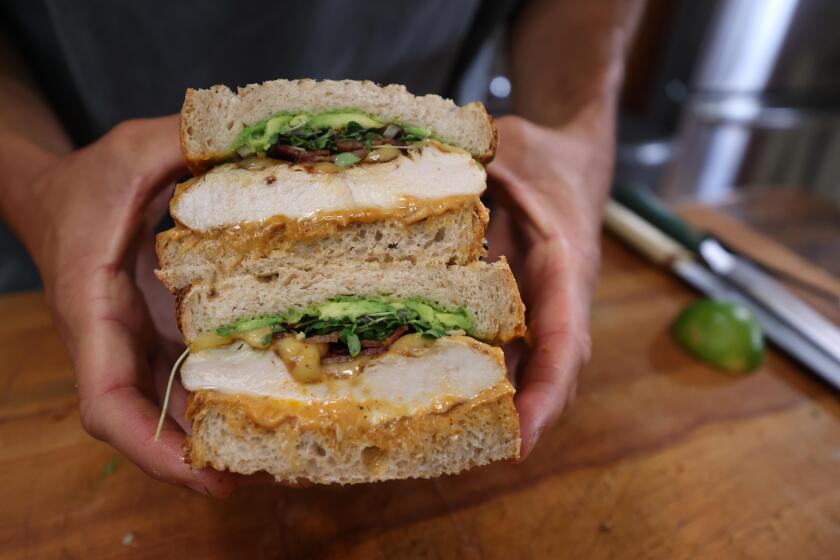In a Pickle? Look Way Down South
Conventional wisdom has it that Southern cooks don’t trust vegetables to speak for themselves. They fry them, candy them, souffle them, boil them with pork fat.
As historian Joe Gray Taylor recalled in “Eating, Drinking and Visiting in the South”: “My father objected to green beans that practically snapped in one’s mouth instead of submitting quietly to mastication, and he insisted that a good pot of beans had to have enough grease in it to wink back when winked at.”
Not as many people lard it up that much anymore. Many cooks have found that they can get deliciously old-fashioned results with less pork seasoning and shorter cooking times. No one complained when Mary Mac’s Tea Room, an Atlanta landmark of traditional Southern dining, switched to boiling turnip greens with chicken stock instead of pork.
There are certain vegetables whose very names seem to have a Southern drawl. Okra, brought to these shores by African slaves, is eaten fried, added to stews and even boiled (despite its sliminess). Black-eyed peas, another slave food, are part of the confusion of peas and beans enjoyed throughout the South. Whether crowders, cowpeas, purple-hulls, pole beans or string beans, they are usually cooked the same way: Boiled with streak o’ lean.
The term “greens” covers another kettle of veggies. Southerners use the word to mean not lettuce and salad greens but turnips, collards, kale, mustard and a dozen other leafy things they eat boiled, along with their nutritious juice, called pot likker. Taken with corn bread, greens make a much-loved meatless dinner, Southern style.
“When we’re talking about greens and pot likker,” said Alabama food writer Eugene Walter, “we’re not just talking about vegetables. We’re talking about religion.”
If so, the high priest--the most distinguished vegetable lover in Southern history--is undoubtedly Thomas Jefferson. From 1766 to 1824, the epicure of Monticello kept a diary recording all the plants he tried growing in the gardens and orchards of his Virginia estate. The March 15, 1774, entry shows his adventurous palate in fine form: On that day seeds of wild endive, Spanish onions, cabbage and lettuce were sown. His curiosity was such that he experimented with 30 varieties of peas alone.
In his 76th year, Jefferson attempted to explain the secret of his longevity in a letter to his doctor. His philosophy would be at home in a healthy-heart cookbook a century and a half later.
“I have lived temperately,” he wrote, “eating little animal food, and that not as an aliment, so much as a condiment for the vegetables, which constitute my principal diet.”
Jefferson must have cooked with only a moderate amount of fat, because there is no record of his vegetables ever winking back at him.
VIDALIA ONION RELISH
Vidalia onions are renowned for being so sweet and mild that you can eat them like an apple without shedding a tear. Wonderful as they are raw, they are also highly versatile and make excellent relishes. This is a delightful condiment for a homey all-vegetable dinner or grilled hamburgers, as well as for a sophisticated entree like filet mignon.
10 pounds Vidalia onions
1/4 cup salt
1 quart apple cider vinegar
1 teaspoon turmeric
2 teaspoons pickling spice
1 1/2 teaspoons minced red bell pepper
4 1/2 cups sugar
Peel and trim onions. In food processor fitted with large-holed shredding disk, grate onions in batches and transfer to large bowl. Or, use coarse side of metal box grater. Stir in salt until well blended. Cover and let stand for 30 minutes at room temperature.
Using your hands, squeeze out as much juice as possible from onions, discarding juice and transferring onions to large, heavy nonreactive pot. Stir in vinegar, turmeric, pickling spice, bell pepper and sugar until well blended. Set pot over medium-high heat and bring to boil, stirring often. Reduce heat to low and simmer, stirring often, until mixture has thickened and most liquid has evaporated, leaving just enough to coat onions, about 30 minutes.
Working quickly, pack relish into hot, sterilized pint jars, leaving 1/2 inch head space. Wipe jar rims and seal. Process for 10 minutes in hot-water bath. Store in cool, dark place for up to 1 year. Refrigerate after opening.
Makes 8 pints.
Each 1/4-cup serving contains about:
76 calories; 365 mg sodium; 0 cholesterol; 0 fat; 19 grams carbohydrates; 1 gram protein; 0.31 gram fiber.
* Note: Home preserves and canned goods must be put up in sterilized jars and must be made using sterilized equipment. To sterilize the jars, boil them gently in water to cover for 10 minutes; leave them in the water until you are ready to fill them. To process any preserves for shelf-stable storage, further important steps must be followed for the safety of the product. Please contact your county Cooperative Extension office, found under your county listings in the Yellow Pages. This office provides current information from the U.S. Department of Agriculture and Land Grant University System for safe home-preserving procedures.
CHOWCHOW
Americans have been pickling their summer bounty for year-round use for more than 200 years. Chowchow, a spicy pickled relish, has been cherished throughout the United States--but especially in the South--since the mid-1800s. Although ingredients vary somewhat from one recipe to the next, most contain cabbage, onions, bell peppers, cucumbers, green tomatoes and whatever else there is an excess supply of in the garden.
1/2 cup kosher salt
2 quarts cold water
2 cups shredded green cabbage
2 cups finely diced cucumber
2 cups coarsely chopped green bell pepper
2 cups finely chopped yellow onion
2 cups finely chopped green tomatoes
2 cups small lima beans
2 cups coarsely chopped green beans
2 cups coarsely chopped carrots
2 to 2 1/2 quarts boiling water, or as needed
4 cups sugar
1 quart distilled white vinegar
1/4 cup yellow mustard seeds
2 tablespoons celery seeds
1 tablespoon ground turmeric
Stir salt into cold water in large nonreactive bowl until dissolved. Stir in cabbage, cucumber, bell pepper, onion and green tomatoes until well blended. Cover and soak overnight in refrigerator.
Next day, combine lima beans, green beans and carrots in large, heavy nonreactive pot. Add enough boiling water to cover mixture by 1/4 inch. Cook over medium heat, stirring occasionally, until just tender, about 3 minutes. Drain and transfer back into pot. Then drain vegetables that have been soaking overnight and stir into pot of beans and carrots.
Set pot over medium heat. Stir in sugar, vinegar, mustard seeds, celery seeds and turmeric until well blended. Bring to boil. Reduce heat to medium low and simmer, stirring occasionally, 10 minutes.
Working quickly, pack relish into hot sterilized pint jars, leaving 1/2-inch head space. Wipe jar rims and seal. Process 15 minutes in hot-water bath. Store in cool, dark place up to 1 year. Refrigerate after opening.
Makes 8 pints.
Each 1/4-cup serving contains about:
65 calories; 903 mg sodium; 0 cholesterol; 0 fat; 16 grams carbohydrates; 0 protein; 0.35 gram fiber.
PICKLED WHOLE OKRA
3 pounds small okra
Fresh dill sprigs
3 cups distilled white vinegar
3 cups water
6 tablespoons kosher salt
1/2 teaspoon red pepper flakes
Even if you have sampled cooked okra, which can have a slightly gelatinous texture, it is an eye-opener to taste pickled okra. Pickling brings out the sprightly character of okra, and the texture is crisp but tender. Pickled okra is a delightful addition to a platter of crudites and goes well with cooked beans, greens, chicken or turkey. Choose small, tender okra pods for the best results.
Trim okra pods to remove any darkened stem tips, but do not remove caps entirely and leave each pod intact with stem stub. Rinse okra well and drain. Using small sharp knife, prick each pod twice in 2 places.
Working quickly, pack okra into hot sterilized pint jars, placing pods vertically side by side, alternating direction of caps. Pack just tight enough to keep pods standing upright. Insert 2 dill sprigs into each jar with okra, leaving 3/4-inch head space.
Bring vinegar, water, salt and red pepper flakes to boil in large, heavy nonreactive pot. Pour boiling liquid into jars, covering okra by 1/4 inch and leaving 1/2-inch head space. Slide clean, new plastic chopstick or wooden skewer along inside of each jar to release any air bubbles. Wipe jar rims and seal. Process for 15 minutes in hot-water bath. Store in cool, dark place to let pickles mellow for 8 weeks before serving. Store up to 1 year. Refrigerate after opening.
Makes 6 pints.
Each 1/4-cup serving contains about:
18 calories; 1,331 mg sodium; 0 cholesterol; 0 fat; 4 grams carbohydrates; 0 grams protein; 0.37 gram fiber.
* Reid Rogers, Auchnutey and Puckett are the authors of the newly released “The South the Beautiful Cookbook” (Collins San Francisco).
More to Read
Eat your way across L.A.
Get our weekly Tasting Notes newsletter for reviews, news and more.
You may occasionally receive promotional content from the Los Angeles Times.










